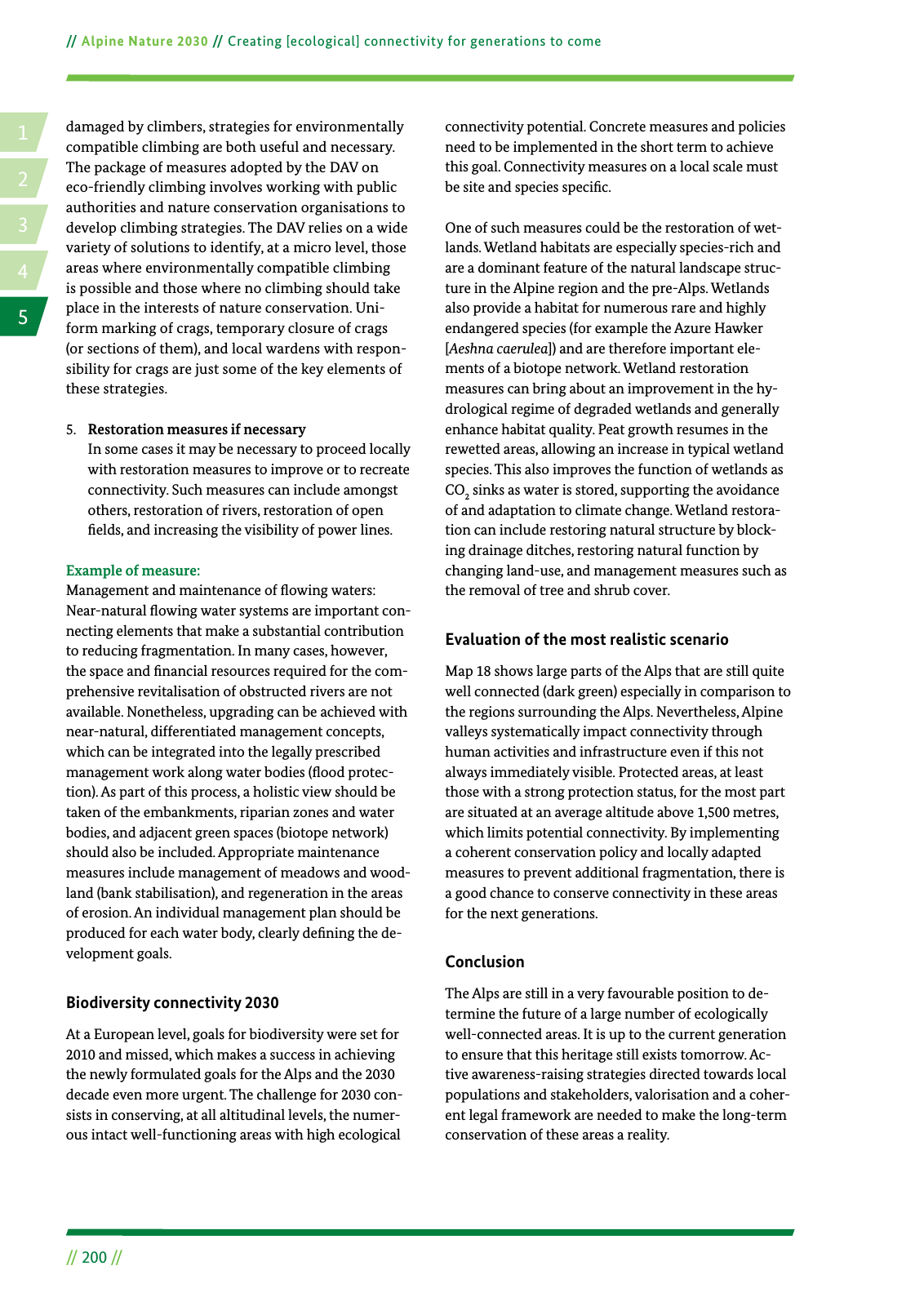14 2 5 3 Alpine Nature 2030 Creating ecological connectivity for generations to come 200 damaged by climbers strategies for environmentally compatible climbing are both useful and necessary The package of measures adopted by the DAV on eco friendly climbing involves working with public authorities and nature conservation organisations to develop climbing strategies The DAV relies on a wide variety of solutions to identify at a micro level those areas where environmentally compatible climbing is possible and those where no climbing should take place in the interests of nature conservation Uni form marking of crags temporary closure of crags or sections of them and local wardens with respon sibility for crags are just some of the key elements of these strategies 5 Restoration measures if necessary In some cases it may be necessary to proceed locally with restoration measures to improve or to recreate connectivity Such measures can include amongst others restoration of rivers restoration of open elds and increasing the visibility of power lines Example of measure Management and maintenance of owing waters Near natural owing water systems are important con necting elements that make a substantial contribution to reducing fragmentation In many cases however the space and nancial resources required for the com prehensive revitalisation of obstructed rivers are not available Nonetheless upgrading can be achieved with near natural differentiated management concepts which can be integrated into the legally prescribed management work along water bodies ood protec tion As part of this process a holistic view should be taken of the embankments riparian zones and water bodies and adjacent green spaces biotope network should also be included Appropriate maintenance measures include management of meadows and wood land bank stabilisation and regeneration in the areas of erosion An individual management plan should be produced for each water body clearly de ning the de velopment goals Biodiversity connectivity 2030 At a European level goals for biodiversity were set for 2010 and missed which makes a success in achieving the newly formulated goals for the Alps and the 2030 decade even more urgent The challenge for 2030 con sists in conserving at all altitudinal levels the numer ous intact well functioning areas with high ecological connectivity potential Concrete measures and policies need to be implemented in the short term to achieve this goal Connectivity measures on a local scale must be site and species speci c One of such measures could be the restoration of wet lands Wetland habitats are especially species rich and are a dominant feature of the natural landscape struc ture in the Alpine region and the pre Alps Wetlands also provide a habitat for numerous rare and highly endangered species for example the Azure Hawker Aeshna caerulea and are therefore important ele ments of a biotope network Wetland restoration measures can bring about an improvement in the hy drological regime of degraded wetlands and generally enhance habitat quality Peat growth resumes in the rewetted areas allowing an increase in typical wetland species This also improves the function of wetlands as CO 2 sinks as water is stored supporting the avoidance of and adaptation to climate change Wetland restora tion can include restoring natural structure by block ing drainage ditches restoring natural function by changing land use and management measures such as the removal of tree and shrub cover Evaluation of the most realistic scenario Map 18 shows large parts of the Alps that are still quite well connected dark green especially in comparison to the regions surrounding the Alps Nevertheless Alpine valleys systematically impact connectivity through human activities and infrastructure even if this not always immediately visible Protected areas at least those with a strong protection status for the most part are situated at an average altitude above 1 500 metres which limits potential connectivity By implementing a coherent conservation policy and locally adapted measures to prevent additional fragmentation there is a good chance to conserve connectivity in these areas for the next generations Conclusion The Alps are still in a very favourable position to de termine the future of a large number of ecologically well connected areas It is up to the current generation to ensure that this heritage still exists tomorrow Ac tive awareness raising strategies directed towards local populations and stakeholders valorisation and a coher ent legal framework are needed to make the long term conservation of these areas a reality

Hinweis: Dies ist eine maschinenlesbare No-Flash Ansicht.
Klicken Sie hier um zur Online-Version zu gelangen.
Klicken Sie hier um zur Online-Version zu gelangen.